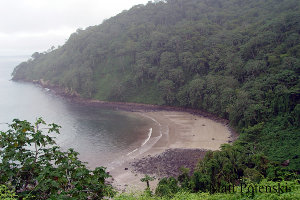The same phenomenon occurs in New Zealand where lobster pots are so numerous along the protected zone’s edge they resemble a defined border like a swim zone. The fish and invertebrates protected inside the reserve are spilling out to the areas outside the protection.
Larval fish spread out in the current, casting seeds for future fish downstream.
The problem in any case is observance and enforcement. There have been success in countries with resources to enforce and convict violators, but many of the areas on the global map are in name only - "paper parks." Boats fish freely in world heritage sites and areas designated protected by governments. I am writing this from one such area outside Cocos Island approximately 400 miles off the coast of Costa Rica. I am currently with a team of Costa Rican biologists from the environmental organization Pretoma on the vessel Sirneuse to film and tag turtles and sharks at Cocos Island.
Cocos is a volcano rising from the deep sea and is an oasis of life from sharks and large fish to manta rays. The government has designated a no-take area 12 miles around Cocos Island over a decade ago, but there has been rampant poaching in the reserve. Recently Costa Rica created the Seamount Management Marine Area that will extend the Cocos Island protected area to 9640 Km2 (nearly 3700 square miles) has been established to protect pinnacles and migratory pathways for fish and sharks. The objective is to protect sharks and other species at risk such as sea turtles from the tuna fishery.
However, these areas are fished for tuna and even sharks with little fear of enforcement.
The Protema biologists tell me that there are several challenges enforcing illegal fishing within the protected zone. The law says that the longlines set for fish must be attached to the boat and inside the reserve to be enforced. Costa Rica does not have a navy, and the Coast Guard primarily enforces against illegal drugs and not fishing. The rangers and the non profit located on Cocos (Marviva) can only report illegal activity to the authorities. If enforcement arrives, they generally find an abandoned longline filled with dead fish and sharks.
Despite public denial by officials, sharks are being finned in Costa Rican waters. Finning is illegal in Costa Rica, yet it is common knowledge that shark fins have been unloaded at private docks behind guarded compounds. Two weeks ago Pretoma forced the courts to uphold the law requiring sharks to be landed at the public docks. Not long after the crew of a Taiwan flagged vessel was apprehended unloading shark fins at the public docks. "The system is working", said Randall Arauz, president of Pretoma. "Clearly, the international fleet needs the privacy of its private docks to hide its shark finning activities, but now it must respect our laws", added Arauz with satisfaction.
In order to protect marine resources we need to have the support of the public and vigilance by watchdogs like Pretoma. However, protecting the ocean from the impacts of fishing are difficult even with enforcement, Protecting the waters from impacts from the land such as run off and ocean acidification cannot be implemented by drawing a line on a map. In San Francisco the last
stage of the MLPA is now underway. With significant influence from
the and, and with potential sea level rise, the best we can do is protect and restore damaged habitat and protect large enough areas such as ecosystems which include fish like our shark nurseries and habitat for sea grass and native oysters to flourish.
Protecting far ranging species like sharks through MPAS is also not easily attained. Sharks cross international borders and roam far past the protection of any single marine protected area. Open ocean MPA’s have been proposed but will take international agreement and the cooperation of the pelagic fishing fleet. At best we can protect nurseries such as the San Francisco Bay and Biodiversity hot spots in the ocean like the waters surrounding Cocos Island. Islands and submarine pinnacles such as Cocos and the new protected area are theoretically large enough to better protect the large migratory species like some species of sharks. However, we need to increase enforcement and alter consumption patterns to support sustainable fisheries. Clearly eating shark fin, or Bluefin tuna sushi is not sustainable. Even with good enforcement, there will be problems, but recognizing the need for marine protected areas is a place to start, even if it’s still only on paper.
 I'm currently with a team of Costa Rican biologists from the environmental organization Pretoma on the vessel Sirneuse to film and tag turtles and sharks at Cocos Island. Image courtesy of Matt Potenski and Pretoma.
I'm currently with a team of Costa Rican biologists from the environmental organization Pretoma on the vessel Sirneuse to film and tag turtles and sharks at Cocos Island. Image courtesy of Matt Potenski and Pretoma.